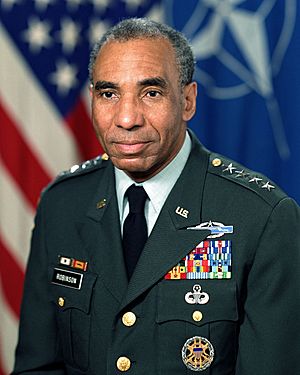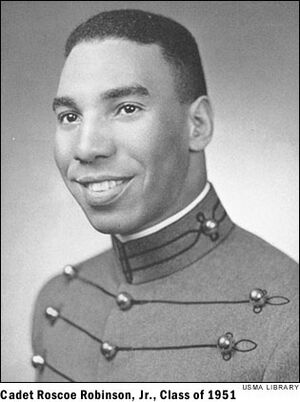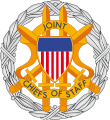Roscoe Robinson Jr. facts for kids
Quick facts for kids
Roscoe Robinson Jr.
|
|
|---|---|

General Roscoe Robinson Jr.
|
|
| Born | October 11, 1928 St. Louis, Missouri |
| Died | July 22, 1993 (aged 64) Washington, D.C. |
| Buried | |
| Allegiance | United States of America |
| Service/ |
|
| Rank | General |
| Commands held | United States Army Garrison, Okinawa 2nd Brigade, 82nd Airborne Division 2nd Battalion, 7th Cavalry Regiment |
| Battles/wars | Korean War Vietnam War |
| Awards | Defense Distinguished Service Medal Army Distinguished Service Medal (2) Silver Star Medal (2) Legion of Merit (3) Distinguished Flying Cross Bronze Star Medal Air Medal (11) |
Roscoe Robinson Jr. (born October 11, 1928 – died July 22, 1993) was a very important person in the United States Army. He made history by becoming the first African American to reach the rank of four-star general. This is the highest rank an officer can achieve in the U.S. Army. General Robinson also represented the United States on the NATO Military Committee. Before that, he led the famous 82nd Airborne Division and the United States Army, Japan.
Contents
Early Life and Education
Roscoe Robinson Jr. was born and grew up in St. Louis, Missouri. He finished Sumner High School in 1946. After high school, he went to Stowe College for a short time. He then studied at Saint Louis University for a year. In 1947, he transferred to the United States Military Academy at West Point.
Becoming an Engineer
At West Point, he studied military engineering. He earned his degree in 1951. After West Point, Robinson continued his military education. He attended the United States Army Infantry School in 1957. He also went to the Command and General Staff College in 1963. The next year, he earned a master's degree from the University of Pittsburgh. He later graduated from the National War College in 1969.
Military Career Highlights
After finishing West Point, Robinson joined the military. He served in the Korean War in 1952. There, he was a platoon leader and led a rifle company. He was recognized for his bravery and received the Bronze Star Medal. A year later, he returned to the United States. He became an instructor at the United States Army Airborne School.
Serving in Vietnam
In 1967, Robinson served in the Vietnam War. He was the commander of the 2nd Battalion, 7th Cavalry. This unit was part of the 1st Cavalry Division. For his excellent service in Vietnam, he received several awards. These included the Legion of Merit, the Distinguished Flying Cross, and two Silver Stars. He also earned 11 Air Medals.
Rising Through the Ranks
After the Vietnam War, he worked at the National War College. He then served in Hawaii with the United States Pacific Command. In 1972, he took command of the 2nd Brigade, 82nd Airborne Division at Fort Bragg.
In 1973, Robinson became a Brigadier General. By 1975, he was leading the United States Army Garrison in Okinawa. In 1976, he was promoted to Major General. He was then put in charge of the 82nd Airborne Division at Fort Bragg. General Robinson was the first African American to lead this famous division. Later, he became the Deputy Chief of Staff for Operations in Europe. In 1980, he became a Lieutenant General. He commanded the United States Army, Japan and IX Corps. He received the Army Distinguished Service Medal in 1983.
Final Assignment and Retirement
General Robinson's last job was very important. From 1982 to 1985, he was the U.S. Military Representative to the NATO Military Committee. He served in the U.S. military for 34 years. He retired on November 30, 1985. When he retired, he received the Defense Distinguished Service Medal. He also received a second Army Distinguished Service Medal.
Later Life and Legacy
After retiring from the Army, General Robinson stayed busy. He helped review the performance of some army units during the Korean War. He also served on the board of Northwest Airlines. General Robinson and his wife, Mildred, lived in Falls Church, Virginia.
His Passing and Honors
Sadly, General Robinson passed away on July 22, 1993. He was 64 years old and had been battling leukemia. He died at the Walter Reed Army Hospital in Washington, D.C. He was buried at Arlington National Cemetery. In April 2000, a new auditorium at West Point was named in his honor. It is called the "General Roscoe Robinson Jr. Auditorium." The Roscoe Robinson Health Clinic at Womack Army Medical Center at Fort Bragg is also named after him.
Images for kids




